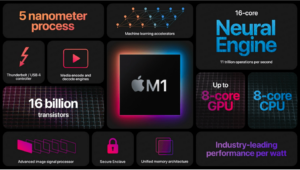Everything you were wondering about Apple’s new M1 chip
California, November 11, 2020: Apple announced three new Macs last night based on its own M1 chip: the MacBook Air, the MacBook Pro, and the Mac Mini. The company’s indigenous ARM-based chip marks the start of its transition from Intel CPUs on its own computers.
The new chip packs a lot of interesting stuff, so let’s get straight into it.
Specifications
The M1 processor has eight cores — four high-performance and four efficiency — with a claimed 3.5x performance boost. It also features a 12MB L2 cache which makes data processing faster.
The chip has whopping 16 billion transistors, made possible by the 5nm fabrication process. Anandtech notes that this might result in roughly a 120mm² sized processor.
There’s also an eight-core GPU with advertised 6x performance overhead. Apple says it can run 25,000 threads simultaneously, making it capable of handling multiple 4K streams or rendering 3D graphics. There’s also a 16-core neural engine that’s capable of 11 trillion operations per second.

Apple’s ARM-based CPU is compatible with Thunderbolt with support for USB-4, resulting in potential 40Gbps data transfer speed. For security, it has the latest Secure Enclave and storage controller with AES encryption hardware. Plus, there’s support for run-time protections on macOS Big Sur.
What does it mean for you?
First of all, Apple’s new Macs are here with the M1 chip: a MacBook Air, a MacBook Pro, and a Mac Mini. The ARM architecture is suited for mobile machines as they provide efficient performance and great battery life.
That’s why Apple claimed that the new MacBook Air and MacBook Pro have video playback battery life of 18 and 20 hours. Now, we might get lower battery life than that with mixed usage. But anything above 10-12 hours will be sufficient for a day’s usage on a single charge, and that’s impressive.
One of the reasons for this is that the M1 chip uses a unified memory architecture. So, different resources of the CPU don’t need to go back and forth to different data pools to fetch data, resulting in faster processing times.

Apple advertised a lot of performance gains — faster times to compile code, render videos, or work on songs — over its Intel counterparts, I’m not gonna list them all but you can learn all about it on Apple’s product announcement page.
One of the coolest things about Macs with the M1 chip is instant wake up from sleep. Macs already had a short wake-up time, but this makes Apple’s machines cooler. Plus, the chip’s Imagine Signal Processor (ISP), will help enhance video calls even if MacBooks will ship with the same old 720p camera.
Apple also said that you’ll be able to run iOS apps on macOS because of the shared ARM architecture. While the company’s slide showed Among Us and HBO Max iOS apps running on new machines, we don’t have official information on what apps will be available at the launch.
Limitations
At the moment, we know of two noteworthy limitations of Apple’s M1 chip. The processor has an in-built DRAM (Dynamic RAM), making it impossible for users to upgrade the RAM size. So, 16GB is the maximum you’re getting at this moment.
Second, the ARM-based chip doesn’t support external graphics cards. That means you can’t drum up your new Mac Mini into a more powerful machine.
The future
Apple’s new chip and machines seem promising on paper. We are yet to see if the company’s claims of performance superseding current desktop CPUs are true or not. We might also see some glitches along the way, because of the transition.
But we’ll expect to see more machines from Apple powered by ARM-based processors resulting in better battery life and possibly more power. Your move, Intel.







